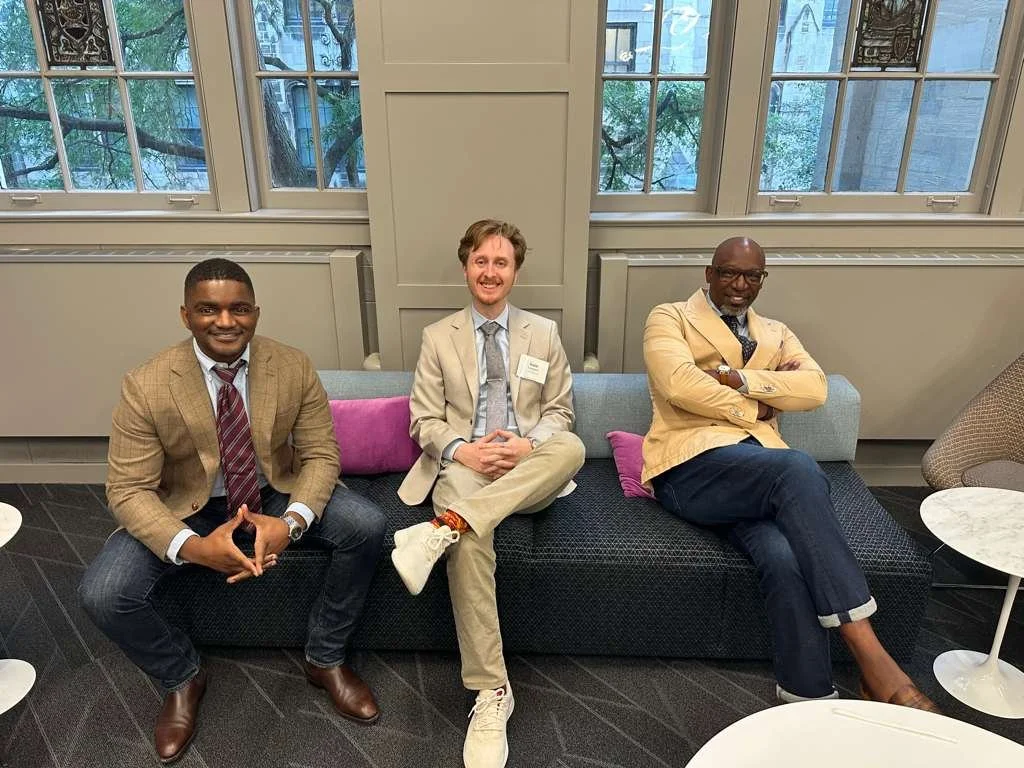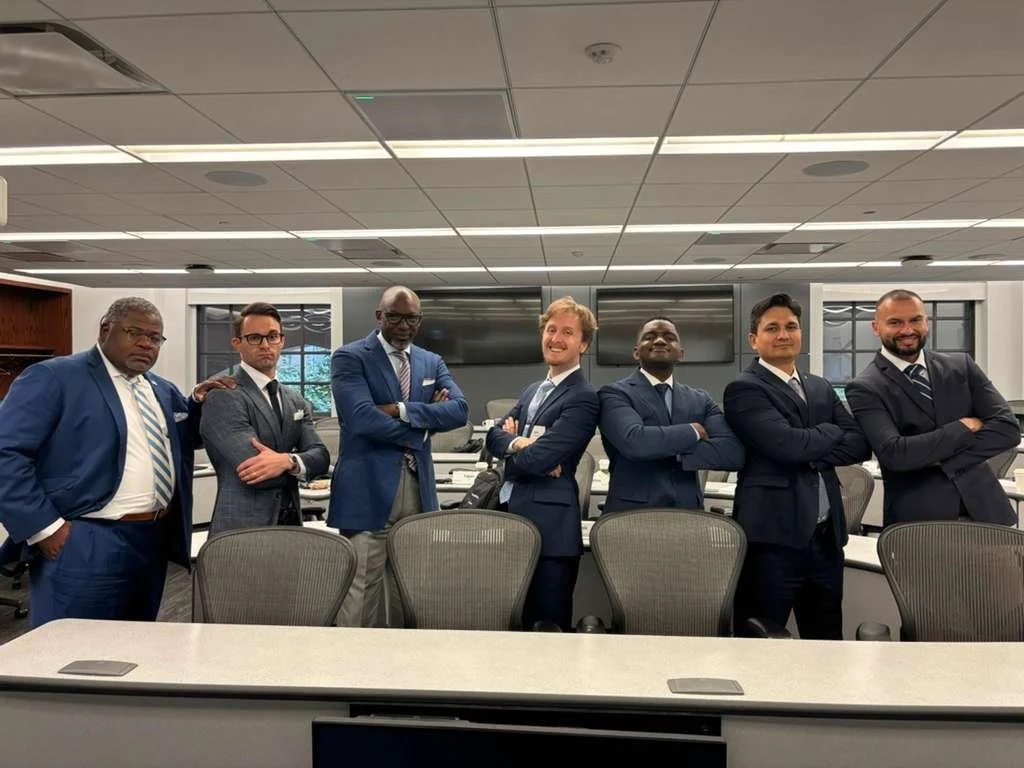The Tale of the Tie Guys
“Are you two wearing the same suit?”
Last weekend, I watched the final round of the October 2025 International Mock Trial league championship. Two of my teams were competing for the gold.
Good work, team.
While it was a close, contentious round, the plaintiff side won every ballot. After the announcement, as the competitors/friends debriefed, they remarked that the plaintiff attorneys were wearing matching light blue blazers.
There’s no rule that says you need to dress formally, or need to color coordinate, but the champs clearly understood that clothes make the championship.
I only really figured out how much I enjoyed dressing up once I started my six years of teaching debate at a public charter school. Since the school’s students competed nearly every weekend, we created an informal culture around matching colors as a sign of camaraderie (in an activity that doesn’t allow school uniforms or other obvious signifiers of team affiliations).
Good work, team.
I have around 10 years of informally considering how colors impact judge perception. I’m not a trained color analyst (though I love watching YouTube analyses!) — just a guy who likes doing deep dives into niche subjects related to public speaking.
Where Is My Super Suit?
The enclothed cognition effect suggests that what you wear impacts how you think and act. There’s good research that folks who suited up before doing creative/organizational tasks outperformed their casual peers.
However, some other studies suggest that if you’re more comfortable, you feel less restricted and more authentic.
So the challenge is to wear formal clothes that improve your self-esteem without compromising on comfort. Here’s how I bridged these gaps across the years.
High School Debate
My first public speaking moment hit freshman year. My argument aged pretty well. I spoke about what Richard Reeves would detail years later in Of Boys and Men: that elementary and middle school are structured to disproportionately punish normal boyish behavior.
The problem? I had no suit.
The solution? A poofy purple shirt. (Thankfully, no surviving photos.)
I got a B. That pushed me to think a lot harder about speaking. Within a year, I’d joined competitive forensics. By senior year, I’d rotated through a groovy red-and-black tie, my dad’s old pinstripe blazer, and finally a light blue tie that matched my eyes.
The grade that stung became the push that stuck.
Undergraduate Mock Trial
Freshman year, I played a toymaker witness. Quirky, tie-less.
Sophomore year brought a dark brown suit and gold tie. Both were gone within a year (I outgrew the suit and lost the tie).
I’m playing an expert on alcohol.
Junior year, I bought a dark gray Zara suit I still wear. I alternated between green and gold ties.
That tie clip is askew.
Senior year, I upgraded to a dark pinstripe suit—and promptly lost the pants at the dry cleaner. My teammate Gokul lent me his. I competed in pinstripe top, plain bottom. It drove me nuts, so switched to light gray. Blue tie for national finals. That look—gray suit, blue tie—became my signature.
I look like Jesse Pinkman.
Teaching
At 22, I was teaching students barely younger than me. I dressed up to look credible. Problem was, my students debated in suits too. Judges couldn’t tell who was the coach.
So I started experimenting. I collected cotton, silk, and linen ties. I ditched polyester after reading about microplastics.
Then, I fell for paisleys and florals—especially Dazi ties. As my collection grew, so did my confidence.
I bought custom suits from Rocky’s in Studio City and I got hooked on the ritual of matching fabric to message. You can tell when I think that one of my students will place top two at a state or national tournament because of my bright salmon pants.
Graduate School & Professional Speaking
During my doctorate, I returned to debate at the adult level—ProSDA (online) and IPDA (the deep South circuit). At first, I rotated safe blues and reds. Then I discovered turtlenecks. They were comfortable, distinctive, and perfect under lights. I wore one for my TED Talk.
Not sure what this gesture is.
Today, my rule is simple: wear what makes me feel good and helps me perform.
Often, that means khakis, jeans, or corduroys with a blazer. A tie that matches my watch. A gold buckle with a gold clip. Sometimes people notice. Sometimes not. But it makes me happy.
They’re gentlemen and scholars.
At Kellogg, my MBA friends and I started the Tie Guys, a crew that color-coordinates ties for fun. Navy, silver, light blue, purple next.
Here’s my current collection.
The Science of Looking the Part
Your clothes change how the audience sees you, how you see yourself, and what the camera sees—literally.
My socks could better match my tie. Next time!
What Colors Signal
Blue: Trustworthy, calm, professional. Great for panels or investor updates.
Charcoal/Gray: Competent and analytical without being severe. Best for technical talks.
Black: Formal and authoritative.
Green/Teal/Purple: Creative, modern, distinctive. Safer than red under stage lights.
White or Light Blue Shirts: Clean, simple, confidence by contrast.
Shoes: Black = authority, brown = approachability, white = modern.
Culture counts: Red is luck in China; white is mourning. Adjust globally.
Reliable Combos
Navy suit, light-blue shirt, matte navy tie, dark-brown shoes.
Charcoal suit, off-white shirt, textured burgundy tie, black oxfords.
Mid-blue suit, soft white shirt, forest-green tie, brown shoes.
Charcoal suit, crisp white shirt, burgundy tie, black shoes.
So what you can do?
Treat your outfit as part of the performance, not decoration.
Match tone to message: trust, authority, creativity, command.
Favor fit and texture over brand names.
Build a wardrobe you can believe in.
(And start a Tie Guys chapter in your location today!)



























